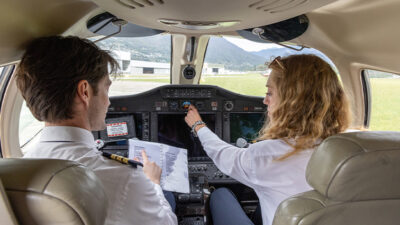Are You Living Up To The Promise of Safety Assurance?

Safety Assurance is a pillar of a Safety Management System and carries a heavy burden of responsibility. Management should focus on three components of Safety Assurance, including safety performance monitoring and measuring, managing change and continuous improvement. Safety Assurance is designed to focus not so much on processes,
but on results.
While it’s often difficult to make sure the performance standards of employees, contractors, FBOs and maintenance service centers match your own, it can be done selectively. A good rule of thumb is to pick those issues that pose the greatest risk to your operation and where your influence might have the greatest effect.
Last quarter I wrote about Safety Communication, a critical element of the Safety Promotion arm of a Safety Management System. Now let’s talk about Safety Assurance, another pillar of the SMS structure.
“Assurance” is a strong word meaning “full confidence, certainty, and freedom from doubt.” To make a commitment to Safety Assurance carries with it a heavy burden to fulfill that promise; empty assurances rapidly lose respect in the eyes of those who received them. Both ICAO and the FAA identify three elements of Safety Assurance upon which management should focus:
- Safety Performance Monitoring and Measuring
- Management of Change
- Continuous Improvement of the SMS
Monitoring And Measuring
The key function of Assurance is to focus not on the process but on the results. It creates a thorough and effective way of measuring performance and monitoring progress and it goes a long way toward validating management’s commitment to
a strong SMS.
Safety Assurance concepts can be built into the safety tools that already exist in most systems. Hazard and incident reports, safety committee meetings and safety audits can include Assurance concepts that will help you determine if the actions taken in response to a safety issue actually corrected a given situation and improved the system. Safety Assurance will also help you document results and encourage you to avoid actions that merely cover symptoms.
In some areas management must make a special effort to assess the effectiveness of their safety initiatives. For example, there are no specific tools to measure the effectiveness of training, but supervisors should be prepared to evaluate training programs. Do your training programs require only completion of training, or do they evaluate what was learned by each participant? Did the attendees further their professional skills or just take home a certificate?
Similarly, scheduling trips can be a very complex process. Are there safety nets to catch important details if they fall through the cracks? Is there duplication of effort, other than checking and verifying? Are thorough records kept that allow for preparation of meaningful reports on how the aircraft are used, passengers, destinations, etc.? When sending these reports to management, it’s wise to include with them a report on safety performance to reinforce management’s commitment to safety assurance.
Management Of Change
Change management processes should be used whenever an impending change may impact the appropriateness or effectiveness of existing practices. As an example, many departments are now actively considering or already introducing “paperless” cockpit concepts—a move that calls out for management of change. Cockpit chart procedures, checklists, briefings, power supplies, backups, equipment storage and other issues must be thoroughly thought out before the electronic flight bags arrive. A training program should be prepared and administered to crew members. These change issues will be addressed and resolved each on their own schedule, so they need to be considered individually as well as part of the whole package.
Continuous Improvement
A vibrant SMS includes constant review of all processes and procedures. As an example, before the introduction of SMS most flight departments had an emergency response plan that simply resided on their bookshelf. But too often, management neglected to verify the plan’s effectiveness. The spotlight of the continuous improvement part of Safety Assurance sharpens the focus on that plan, demanding periodic review and practice. It goes a long way toward ensuring a prepared and thoughtful response should crisis strike.
Good for you if these pieces are in place to support the Safety Assurance pillar of your SMS. Now take a look around and ask if your policies and procedures apply to everyone who works with your department. Do your contracted helpers, including pilots, maintenance technicians and support personnel adhere to the same training and performance standards as your full-time employees? If not, is there a chink in the armor? Does the supplemental help know your procedures and your standards?
Beyond your flight department, do you deal only with organizations whose performance standards match your own? How about the FBOs and maintenance service centers you use most often? Do you let them know of your expectations? Do you assess their performance in light of your standards? In many instances you can influence how they perform by telling them what is important to you as a customer.
It’s difficult to make sure that everyone else abides by your standards. But, it can be done selectively. Start with those over whom you have the most influence as a customer. This is where risk assessment and mitigation come into play. Pick those issues that pose the greatest risk to your operation and where your influence (mitigation) might have the
greatest effect.
The ultimate objective is continuous improvement of your SMS and your flight organization. Living up to your promise of Safety Assurance will keep you moving in the right direction.

Customized Safety Management programs developed by experienced and credentialed safety professionals include training, manual management and SMS implementation/software. Based on ICAO and other international standards and regulations, Baldwin’s programs support Business Aviation, Charter, FBO, Airport, Medical Transport and Regional Airlines by providing advanced software, an outstanding customer experience and our Commitment to Excellence.
http://www.baldwinaviation.com/
© 2024 Baldwin Safety & Compliance. All Rights Reserved.
Next ArticleRelated Posts

Safety in Numbers: Trends in Aviation Accidents and Incidents
Every accident is preventable; the problem is that we don’t know how to prevent it until after the accident happens. However, what we can do as an industry is honor the anguish of each event by sharing the information, the mistakes and the outcomes to improve safety for everyone.

Is ChatGPT Ready To Analyze My SMS Portal’s Safety Reports?
While industry experts continue to design the next-gen AI-backed SMS software solution, safety managers can use ChatGPT to help them treat safety issues, audit findings and classify hazards contained in their SMS reporting.

